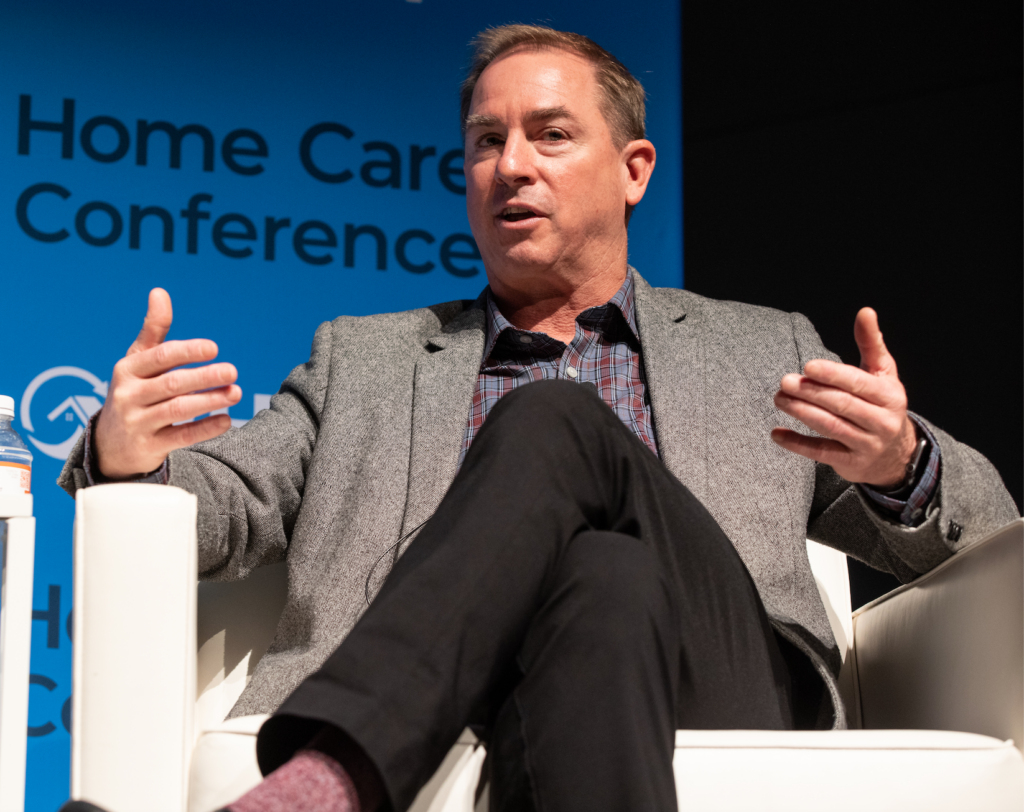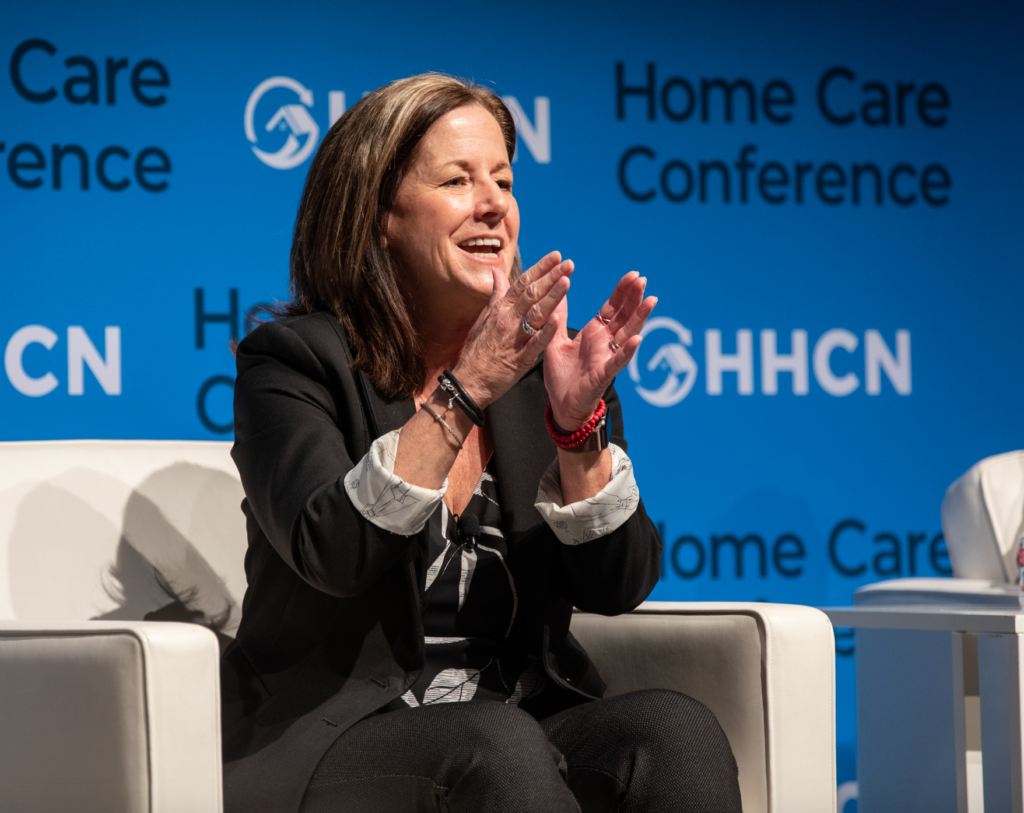While the tailwinds in the market remain, personal home care provider leaders have a lot more to consider about their futures than they did just five years ago.
Their thought processes are still resetting. And as they do, their organizations’ strategies will reflect that.
“As you look across all the providers — whether they’re in a franchise network, independent, whatever the case may be — anyone in the health care space has really gone through a lot of fatigue,” Right at Home CEO Margaret Haynes said this week at Home Health Care News’ Home Care Conference. “We’re just now starting to process that and it’s why maybe when you talk to individuals or family members, they might be a little crispy. It’s really because they’re starting to just come out of what has been a really traumatic experience with the pandemic.”
The Omaha, Nebraska-based Right at Home is a home care franchise company with more than 600 locations in the U.S. and seven other countries.
Despite burnout, providers don’t exactly have time to ease off the gas pedal. More people than ever are aware of home-based care’s potential – a good thing, for certain – and the demographics are such that more people than ever will require care in the U.S. over the next 10 years.

“Everyone uses the 65 and older numbers, and that’s useful in a lot of segments of the economy. But if you look at the 80 and older numbers, and you look back 10 years from 2010 to 2020, we actually had a negative growth rate in that decade,” Caring Senior Service CEO Jeff Salter said at the Home Care Conference. “If you look at the 2020 to 2030 range, we’re projected to have a 96% increase rate. That’s nearly 2.4 million people aging into the age in which our services are needed. We’re seeing that massive wave hit us that we all knew was coming, but I don’t think we prepared ourselves well enough for it.”
Caring Senior Service is a San Antonio-based franchise with about 50 locations across 20 states.
“From 2030 to 2040, that number changes from 2.4 to 5.6 million people turning 80,” Salter said. “If you think you’ve got problems in the last few years in your business, it’s going to be a lot more difficult. I think there are a lot of opportunities for all of us, but it’s a massive number that I’m not sure we’re prepared for.”
All the while, perhaps the biggest contemporary issue for home care providers is the rising cost of services.
For 24 Hour Home Care — a non-medical home care provider based in Los Angeles — rising costs have been significant, especially in metropolitan areas.
“In territories like Los Angeles and Northern California, we’ve seen increases anywhere from 20% to 40%, literally overnight,” Ryan Iwamoto, president and co-founder of 24 Hour Home Care, said at the Home Care Conference. “This is because of the cost of labor, not just with the caregivers, but the cost of our staff and everything that goes along with it. That’s really changed the dynamic of how we do things, especially on the private-pay side, which we do a lot of.”
Both Haynes and Salter suggested that their costs of services had also risen by at least 25% over the last couple of years.
Because of that, 24 Hour Home Care has started to shift its focus to patients that can afford in-home care, as opposed to the general population that needs it. Still, it does plan to expand its reach where it can in the coming years.
“Our strategy has really gone from trying to serve everybody to now focusing on this small population of people and doing it really well,” Iwamoto said.

Those rising costs in home care have also squeezed the margins for a lot of home care providers and franchisees.
“As pay rates go up, obviously bill rates need to go up,” Haynes said. “We’re now at an average bill rate of about $30 an hour, whereas pre-pandemic, that was probably around an average of $24. From a profitability perspective, we’ve had to really focus and help our owners think about that entire income statement.”
Salter, a veteran of the business for 30 years, has seen the meteoric rise of costs firsthand.
“From my perspective, I remember a $6 charge rate for clients,” he said. “To see the rate continue to grow the way it has is shocking. Health care is about helping people and helping families. But we’re also in a unique space in the home care side, especially in the franchising world, where we’re about profitability. That’s not the way you’re supposed to talk about a health care business.”
On the surface, if home care agencies are able to charge higher rates, the market should drive those forces, Salter said. However, framing a health care provider as a business in simple economic phrasing, that’s when the conversation starts to feel “icky,” he said.
In conversations with his owners and other staff members, satisfaction is not an issue. Profits are up across the board at Care Senior Service locations year over year, employees are being paid more to work less because of efficiency and technology, and yet these worries persist in the industry.
“What I’m looking at is trying to understand how someone else in this industry that’s innovative is going to come in and undercut and provide a high level of service,” Salter said. “That’s what I worry more about. I don’t know how we get to where we need to be, but it scares me that someone’s going to be able to come in and really make this business work without having to charge as high of a rate and still provide a high level of service.”

In the meantime, Salter has found success in systematizing workflow, Haynes has found the same by taking repeatable processes and applying technology to the work and Iwamoto has focused on providing value to its patients that they can’t get anywhere else.
“We’re no longer really competing with other home care agencies,” Iwamoto said. “We’re competing with alternatives: doing it themselves, hiring a private caregiver, going to assisted living, boarding care. For us, it really is about providing the value of not going towards the alternative, providing additional value for that extra cost and really making that experience as easy as possible.”




